Evaluating AASB 3: Accounting for Corporate Restructuring
VerifiedAdded on 2023/06/12
|6
|1271
|139
Report
AI Summary
This report provides a critical evaluation of the Australian accounting requirements for business combinations, focusing on AASB 3. It discusses the significance of the reporting entity concept, the implications of using the acquisition method, and the determination of fair values for assets and liabilities. The report also explores the rationale behind using fair value, the treatment of directly attributable costs, the accounting for gains on bargain purchases, and the nature and treatment of goodwill. It concludes that fair value accounting is essential for accurate financial reporting in business combinations and highlights the importance of proper recognition of goodwill and bargain gains. Desklib is a platform where students can find similar solved assignments and study resources.
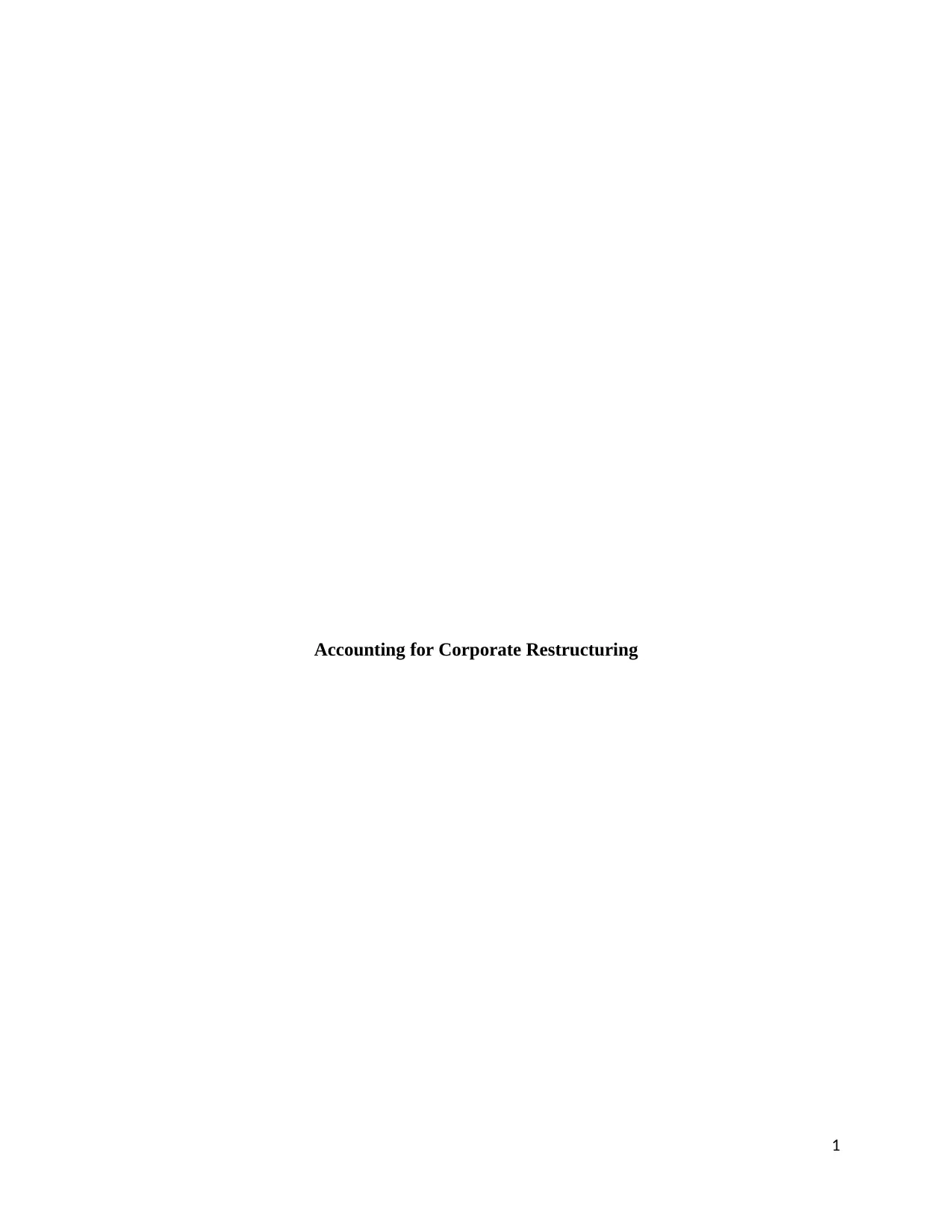
Accounting for Corporate Restructuring
1
1
Paraphrase This Document
Need a fresh take? Get an instant paraphrase of this document with our AI Paraphraser
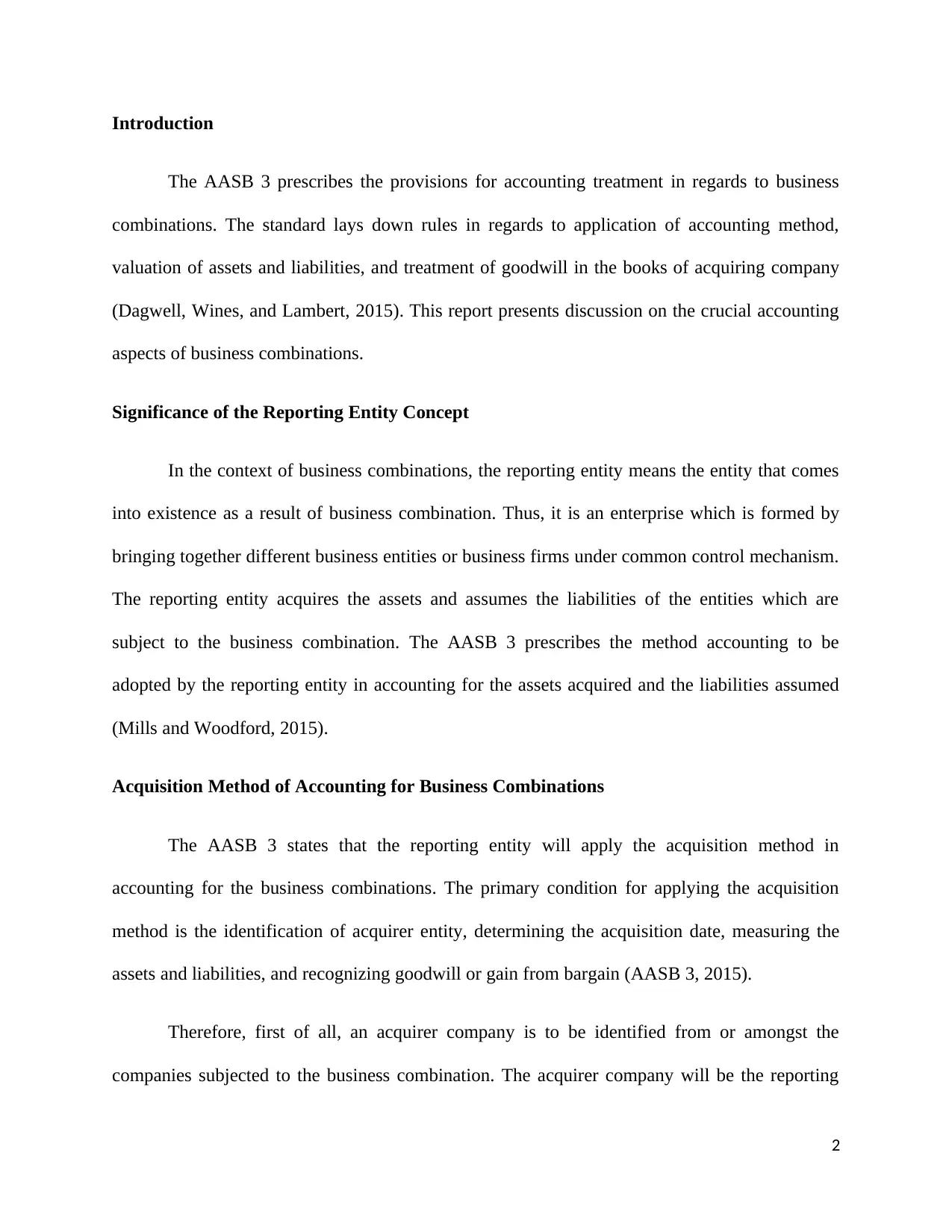
Introduction
The AASB 3 prescribes the provisions for accounting treatment in regards to business
combinations. The standard lays down rules in regards to application of accounting method,
valuation of assets and liabilities, and treatment of goodwill in the books of acquiring company
(Dagwell, Wines, and Lambert, 2015). This report presents discussion on the crucial accounting
aspects of business combinations.
Significance of the Reporting Entity Concept
In the context of business combinations, the reporting entity means the entity that comes
into existence as a result of business combination. Thus, it is an enterprise which is formed by
bringing together different business entities or business firms under common control mechanism.
The reporting entity acquires the assets and assumes the liabilities of the entities which are
subject to the business combination. The AASB 3 prescribes the method accounting to be
adopted by the reporting entity in accounting for the assets acquired and the liabilities assumed
(Mills and Woodford, 2015).
Acquisition Method of Accounting for Business Combinations
The AASB 3 states that the reporting entity will apply the acquisition method in
accounting for the business combinations. The primary condition for applying the acquisition
method is the identification of acquirer entity, determining the acquisition date, measuring the
assets and liabilities, and recognizing goodwill or gain from bargain (AASB 3, 2015).
Therefore, first of all, an acquirer company is to be identified from or amongst the
companies subjected to the business combination. The acquirer company will be the reporting
2
The AASB 3 prescribes the provisions for accounting treatment in regards to business
combinations. The standard lays down rules in regards to application of accounting method,
valuation of assets and liabilities, and treatment of goodwill in the books of acquiring company
(Dagwell, Wines, and Lambert, 2015). This report presents discussion on the crucial accounting
aspects of business combinations.
Significance of the Reporting Entity Concept
In the context of business combinations, the reporting entity means the entity that comes
into existence as a result of business combination. Thus, it is an enterprise which is formed by
bringing together different business entities or business firms under common control mechanism.
The reporting entity acquires the assets and assumes the liabilities of the entities which are
subject to the business combination. The AASB 3 prescribes the method accounting to be
adopted by the reporting entity in accounting for the assets acquired and the liabilities assumed
(Mills and Woodford, 2015).
Acquisition Method of Accounting for Business Combinations
The AASB 3 states that the reporting entity will apply the acquisition method in
accounting for the business combinations. The primary condition for applying the acquisition
method is the identification of acquirer entity, determining the acquisition date, measuring the
assets and liabilities, and recognizing goodwill or gain from bargain (AASB 3, 2015).
Therefore, first of all, an acquirer company is to be identified from or amongst the
companies subjected to the business combination. The acquirer company will be the reporting
2
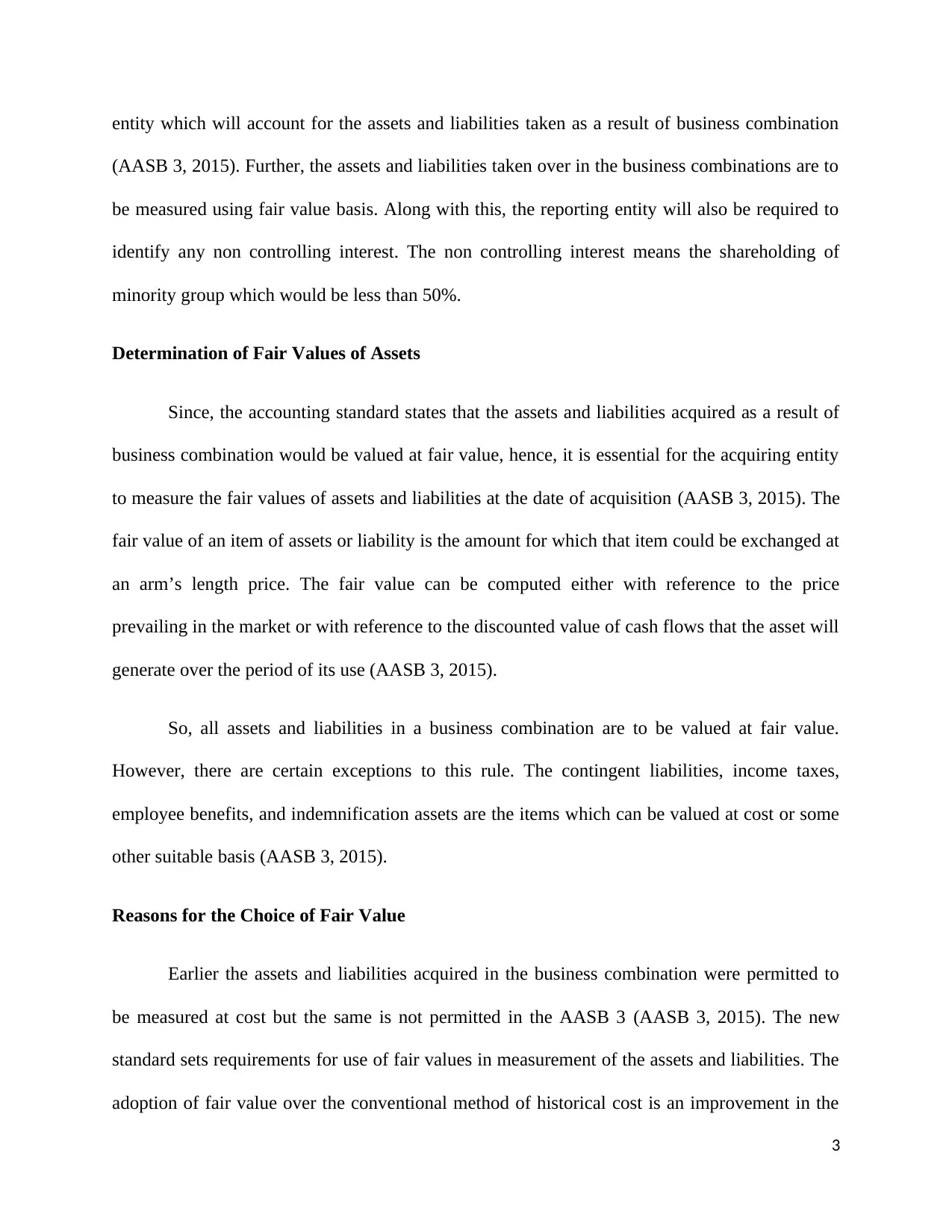
entity which will account for the assets and liabilities taken as a result of business combination
(AASB 3, 2015). Further, the assets and liabilities taken over in the business combinations are to
be measured using fair value basis. Along with this, the reporting entity will also be required to
identify any non controlling interest. The non controlling interest means the shareholding of
minority group which would be less than 50%.
Determination of Fair Values of Assets
Since, the accounting standard states that the assets and liabilities acquired as a result of
business combination would be valued at fair value, hence, it is essential for the acquiring entity
to measure the fair values of assets and liabilities at the date of acquisition (AASB 3, 2015). The
fair value of an item of assets or liability is the amount for which that item could be exchanged at
an arm’s length price. The fair value can be computed either with reference to the price
prevailing in the market or with reference to the discounted value of cash flows that the asset will
generate over the period of its use (AASB 3, 2015).
So, all assets and liabilities in a business combination are to be valued at fair value.
However, there are certain exceptions to this rule. The contingent liabilities, income taxes,
employee benefits, and indemnification assets are the items which can be valued at cost or some
other suitable basis (AASB 3, 2015).
Reasons for the Choice of Fair Value
Earlier the assets and liabilities acquired in the business combination were permitted to
be measured at cost but the same is not permitted in the AASB 3 (AASB 3, 2015). The new
standard sets requirements for use of fair values in measurement of the assets and liabilities. The
adoption of fair value over the conventional method of historical cost is an improvement in the
3
(AASB 3, 2015). Further, the assets and liabilities taken over in the business combinations are to
be measured using fair value basis. Along with this, the reporting entity will also be required to
identify any non controlling interest. The non controlling interest means the shareholding of
minority group which would be less than 50%.
Determination of Fair Values of Assets
Since, the accounting standard states that the assets and liabilities acquired as a result of
business combination would be valued at fair value, hence, it is essential for the acquiring entity
to measure the fair values of assets and liabilities at the date of acquisition (AASB 3, 2015). The
fair value of an item of assets or liability is the amount for which that item could be exchanged at
an arm’s length price. The fair value can be computed either with reference to the price
prevailing in the market or with reference to the discounted value of cash flows that the asset will
generate over the period of its use (AASB 3, 2015).
So, all assets and liabilities in a business combination are to be valued at fair value.
However, there are certain exceptions to this rule. The contingent liabilities, income taxes,
employee benefits, and indemnification assets are the items which can be valued at cost or some
other suitable basis (AASB 3, 2015).
Reasons for the Choice of Fair Value
Earlier the assets and liabilities acquired in the business combination were permitted to
be measured at cost but the same is not permitted in the AASB 3 (AASB 3, 2015). The new
standard sets requirements for use of fair values in measurement of the assets and liabilities. The
adoption of fair value over the conventional method of historical cost is an improvement in the
3
⊘ This is a preview!⊘
Do you want full access?
Subscribe today to unlock all pages.

Trusted by 1+ million students worldwide
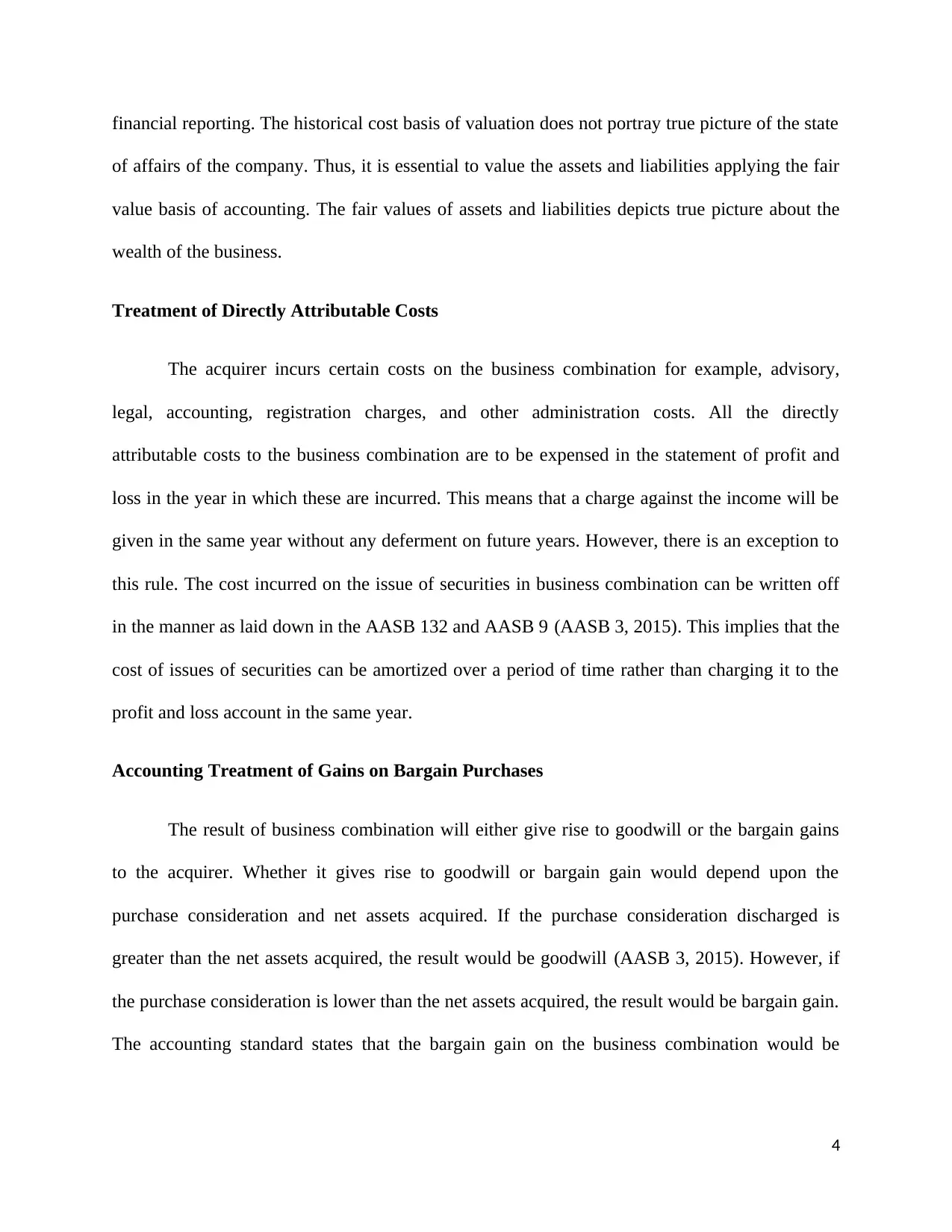
financial reporting. The historical cost basis of valuation does not portray true picture of the state
of affairs of the company. Thus, it is essential to value the assets and liabilities applying the fair
value basis of accounting. The fair values of assets and liabilities depicts true picture about the
wealth of the business.
Treatment of Directly Attributable Costs
The acquirer incurs certain costs on the business combination for example, advisory,
legal, accounting, registration charges, and other administration costs. All the directly
attributable costs to the business combination are to be expensed in the statement of profit and
loss in the year in which these are incurred. This means that a charge against the income will be
given in the same year without any deferment on future years. However, there is an exception to
this rule. The cost incurred on the issue of securities in business combination can be written off
in the manner as laid down in the AASB 132 and AASB 9 (AASB 3, 2015). This implies that the
cost of issues of securities can be amortized over a period of time rather than charging it to the
profit and loss account in the same year.
Accounting Treatment of Gains on Bargain Purchases
The result of business combination will either give rise to goodwill or the bargain gains
to the acquirer. Whether it gives rise to goodwill or bargain gain would depend upon the
purchase consideration and net assets acquired. If the purchase consideration discharged is
greater than the net assets acquired, the result would be goodwill (AASB 3, 2015). However, if
the purchase consideration is lower than the net assets acquired, the result would be bargain gain.
The accounting standard states that the bargain gain on the business combination would be
4
of affairs of the company. Thus, it is essential to value the assets and liabilities applying the fair
value basis of accounting. The fair values of assets and liabilities depicts true picture about the
wealth of the business.
Treatment of Directly Attributable Costs
The acquirer incurs certain costs on the business combination for example, advisory,
legal, accounting, registration charges, and other administration costs. All the directly
attributable costs to the business combination are to be expensed in the statement of profit and
loss in the year in which these are incurred. This means that a charge against the income will be
given in the same year without any deferment on future years. However, there is an exception to
this rule. The cost incurred on the issue of securities in business combination can be written off
in the manner as laid down in the AASB 132 and AASB 9 (AASB 3, 2015). This implies that the
cost of issues of securities can be amortized over a period of time rather than charging it to the
profit and loss account in the same year.
Accounting Treatment of Gains on Bargain Purchases
The result of business combination will either give rise to goodwill or the bargain gains
to the acquirer. Whether it gives rise to goodwill or bargain gain would depend upon the
purchase consideration and net assets acquired. If the purchase consideration discharged is
greater than the net assets acquired, the result would be goodwill (AASB 3, 2015). However, if
the purchase consideration is lower than the net assets acquired, the result would be bargain gain.
The accounting standard states that the bargain gain on the business combination would be
4
Paraphrase This Document
Need a fresh take? Get an instant paraphrase of this document with our AI Paraphraser
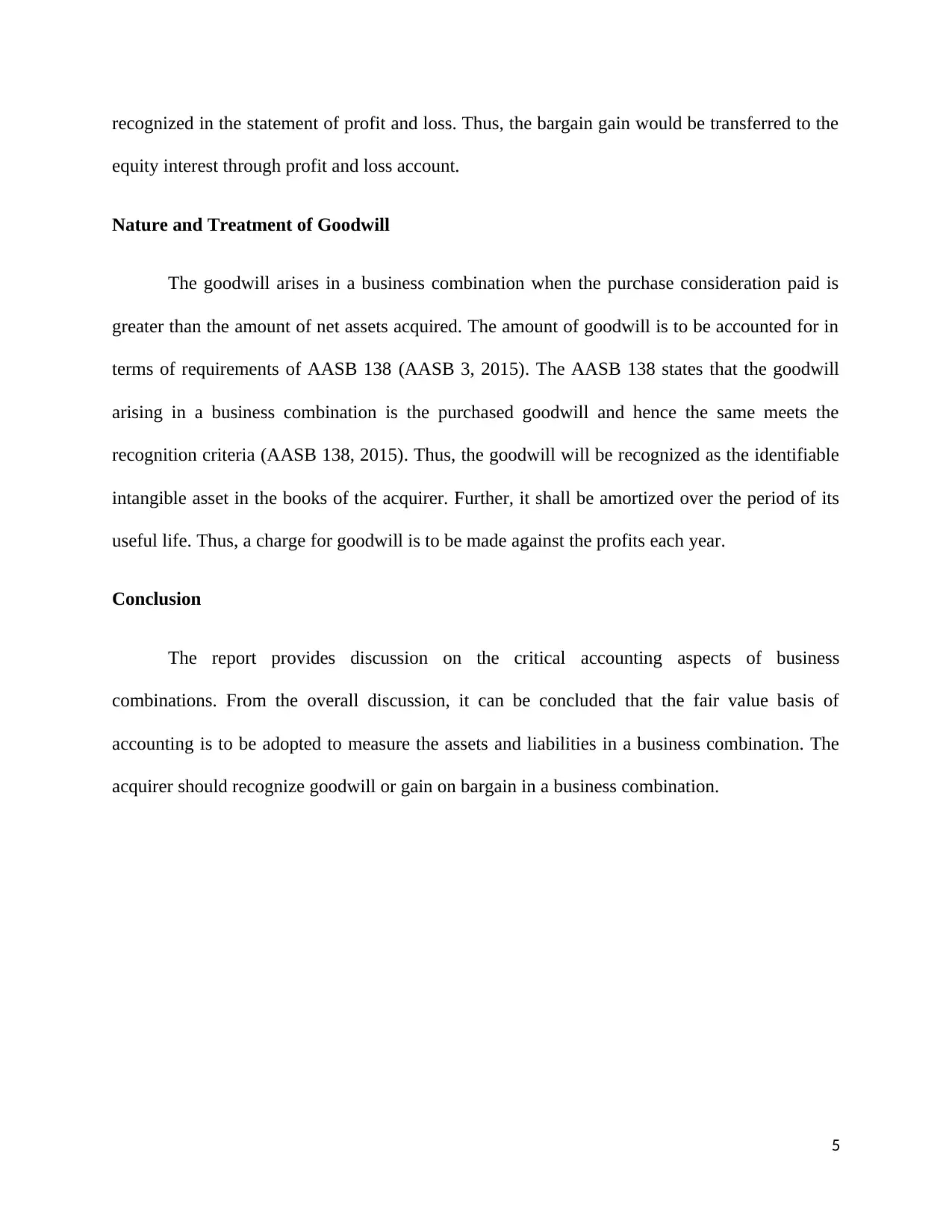
recognized in the statement of profit and loss. Thus, the bargain gain would be transferred to the
equity interest through profit and loss account.
Nature and Treatment of Goodwill
The goodwill arises in a business combination when the purchase consideration paid is
greater than the amount of net assets acquired. The amount of goodwill is to be accounted for in
terms of requirements of AASB 138 (AASB 3, 2015). The AASB 138 states that the goodwill
arising in a business combination is the purchased goodwill and hence the same meets the
recognition criteria (AASB 138, 2015). Thus, the goodwill will be recognized as the identifiable
intangible asset in the books of the acquirer. Further, it shall be amortized over the period of its
useful life. Thus, a charge for goodwill is to be made against the profits each year.
Conclusion
The report provides discussion on the critical accounting aspects of business
combinations. From the overall discussion, it can be concluded that the fair value basis of
accounting is to be adopted to measure the assets and liabilities in a business combination. The
acquirer should recognize goodwill or gain on bargain in a business combination.
5
equity interest through profit and loss account.
Nature and Treatment of Goodwill
The goodwill arises in a business combination when the purchase consideration paid is
greater than the amount of net assets acquired. The amount of goodwill is to be accounted for in
terms of requirements of AASB 138 (AASB 3, 2015). The AASB 138 states that the goodwill
arising in a business combination is the purchased goodwill and hence the same meets the
recognition criteria (AASB 138, 2015). Thus, the goodwill will be recognized as the identifiable
intangible asset in the books of the acquirer. Further, it shall be amortized over the period of its
useful life. Thus, a charge for goodwill is to be made against the profits each year.
Conclusion
The report provides discussion on the critical accounting aspects of business
combinations. From the overall discussion, it can be concluded that the fair value basis of
accounting is to be adopted to measure the assets and liabilities in a business combination. The
acquirer should recognize goodwill or gain on bargain in a business combination.
5
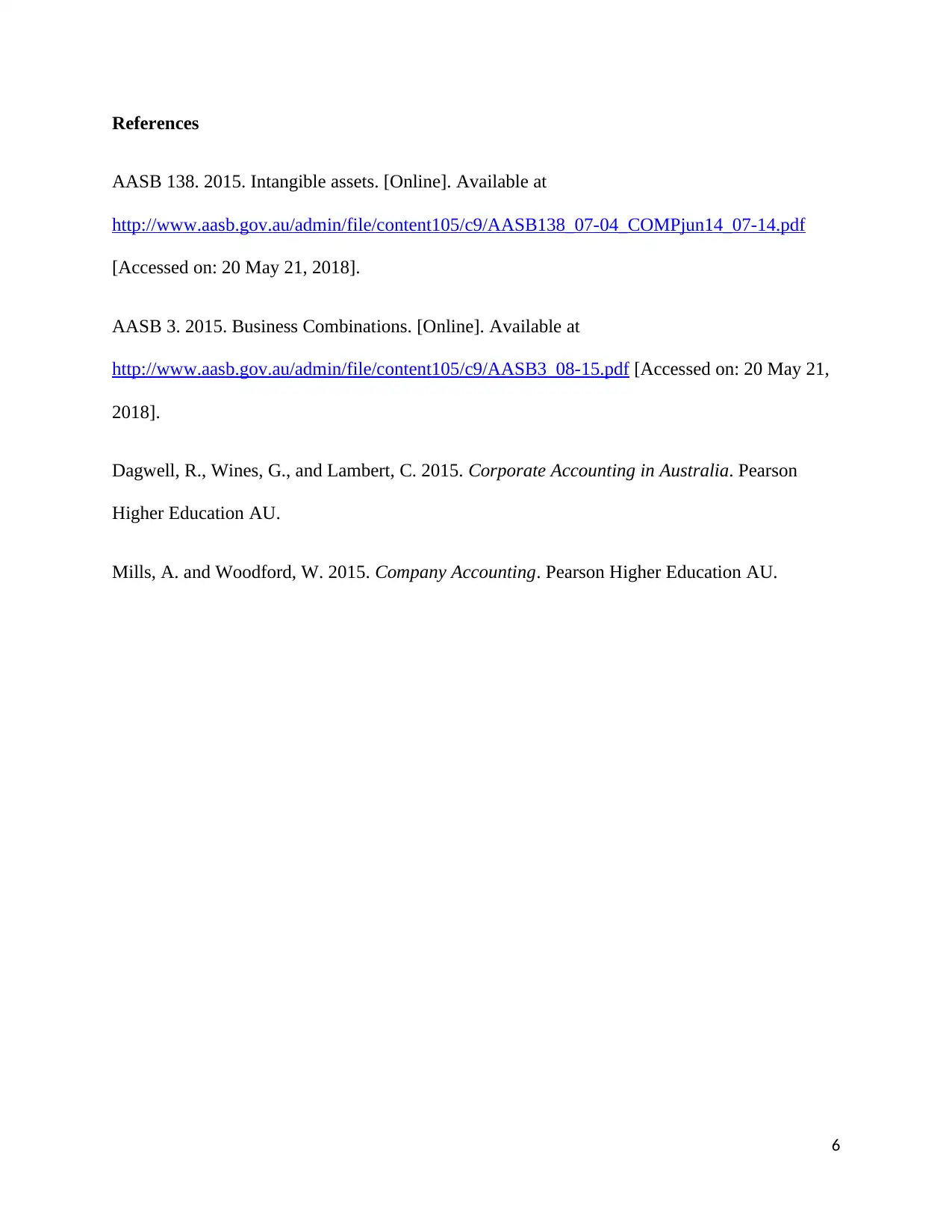
References
AASB 138. 2015. Intangible assets. [Online]. Available at
http://www.aasb.gov.au/admin/file/content105/c9/AASB138_07-04_COMPjun14_07-14.pdf
[Accessed on: 20 May 21, 2018].
AASB 3. 2015. Business Combinations. [Online]. Available at
http://www.aasb.gov.au/admin/file/content105/c9/AASB3_08-15.pdf [Accessed on: 20 May 21,
2018].
Dagwell, R., Wines, G., and Lambert, C. 2015. Corporate Accounting in Australia. Pearson
Higher Education AU.
Mills, A. and Woodford, W. 2015. Company Accounting. Pearson Higher Education AU.
6
AASB 138. 2015. Intangible assets. [Online]. Available at
http://www.aasb.gov.au/admin/file/content105/c9/AASB138_07-04_COMPjun14_07-14.pdf
[Accessed on: 20 May 21, 2018].
AASB 3. 2015. Business Combinations. [Online]. Available at
http://www.aasb.gov.au/admin/file/content105/c9/AASB3_08-15.pdf [Accessed on: 20 May 21,
2018].
Dagwell, R., Wines, G., and Lambert, C. 2015. Corporate Accounting in Australia. Pearson
Higher Education AU.
Mills, A. and Woodford, W. 2015. Company Accounting. Pearson Higher Education AU.
6
⊘ This is a preview!⊘
Do you want full access?
Subscribe today to unlock all pages.

Trusted by 1+ million students worldwide
1 out of 6
Related Documents
Your All-in-One AI-Powered Toolkit for Academic Success.
+13062052269
info@desklib.com
Available 24*7 on WhatsApp / Email
![[object Object]](/_next/static/media/star-bottom.7253800d.svg)
Unlock your academic potential
Copyright © 2020–2025 A2Z Services. All Rights Reserved. Developed and managed by ZUCOL.





